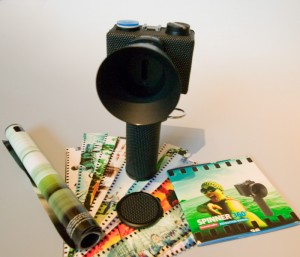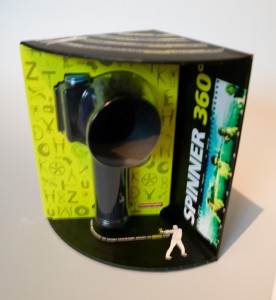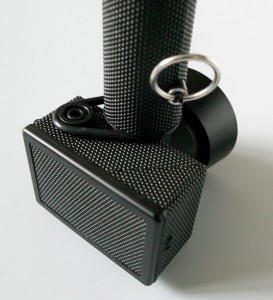 When I first heard about the Lomography Spinner 360, I knew I had to have one. I’ve been racking my brains on how they’ve made this marvel of 360 degree photography a reality without this being a “pro camera”.
When I first heard about the Lomography Spinner 360, I knew I had to have one. I’ve been racking my brains on how they’ve made this marvel of 360 degree photography a reality without this being a “pro camera”.
With a rather sharp retail price of £110, this isn’t just a throwaway toy camera. Medium format alternatives are 50 times that price – so we’re still getting kind of a good deal here.
I’ve had this camera for over three months now and I finally found the time to write up all my findings about this new gadget.
Let’s have a closer look at it in this article.
What’s this camera doing again?
The Spinner 360 is a 35mm camera created by The Lomographic Society. It takes a full 360 degree panoramic photo on one single negative. It spins around its own axis and exposes a 20cm long strip of film, including its perforation. That’s the equivalent of nearly 5 ordinairy pictures next to each other.
On a 36 exposure film you can take roughly 8 pictures (give or take).
Please note that you won’t be able to get prints from this camera at your local mini lab! You can ask them to develop the film for you, but make sure they don’t cut it. You’ll have to scan it yourself. Mini labs can only print 24x36mm negatives and yours will be 24x150mm. If you’re scanning your pictures at 1200 dpi, you’ll roughly end up with an image size of 1500 x 10.000 pixels – so be careful of what size your application can handle.
What’s in the box?
- 1x Lomography Spinner 360 Camera
- 1x metal Lens Hood (pre-attached to the camera)
- 1x Lens Cap (only fits if you de-tach the lends hood first)
- 2x “rubber bands” (they’re 5mm thick so the term is a bit misleading)
- 1x Camera Manual
- 11x “Contact Prints” of example shots, with explanations on how to create them on the back
- 1x pack of Silica Gel (always comes in handy)
- 1x giant poster (ca. 26x100cm, rolled up)
Packaging
 As with many original Lomography products, the mere packaging is amazing! Imagine a cylinder with a diameter of 36cm, 26cm high. Then imagine a quarter wedge cut out of it – that’s your box. It’s a piece of art all by itself.
As with many original Lomography products, the mere packaging is amazing! Imagine a cylinder with a diameter of 36cm, 26cm high. Then imagine a quarter wedge cut out of it – that’s your box. It’s a piece of art all by itself.
I always think of packaging and box art as something very creative, and I love it when it pushes my buttons. This one does – even if you never shoot with the Spinner, the packaging is good enough to get one.
Or maybe I just need to get out more.
The Outside and How to use it
On the whole, you could describe The Spinner as a sturdy, well build camera. It’s covered with rubber on the outside with lots of little nobbles on it – so it won’t slip out of your hand.The whole contraption is rather heavy (400g without the film).
If you’ve seen the Lomography Fisheye before, the camera body looks a little bit like it, extented by a big stick on the bottom. This big stick sits at the front-centre of the camera body and turns counter-clockwise to move the film forward.
 The stick has a thick rubber band at the top which winds on the film. Instead of a “shutter button”, you’ve got a metal ring hanging out of that big grip. Inside the stick is a piece of string with a metal ringattached to it. To take a picture, you hold the stick, pull you the ring and then let go of it. It’s fun, try it a few times without a film in it.
The stick has a thick rubber band at the top which winds on the film. Instead of a “shutter button”, you’ve got a metal ring hanging out of that big grip. Inside the stick is a piece of string with a metal ringattached to it. To take a picture, you hold the stick, pull you the ring and then let go of it. It’s fun, try it a few times without a film in it.
On top of the camera we have a “cold shoe” for strobe flashes or constant light sources, a film rewind crank and a sprit level (featuring blue liquid, a water bubble and a dolphin).
Please note that the “cold shoe” is more like a holder, it’s not a wired hot shoe like you know from other cameras. Your flash won’t fire when you take a picture, unless you set it to manual strobe mode.
I’m sure it will –
they usually come with a mask that scans four strips, and on those strips you can select as many pictures as you like. You’ll manage to scan between 20 and 24 “normal” 35mm pictures.
I am SO PLEASED you explained on your website what was up with the lens cover. Day after day I sat with the Spinner in one hand and the lens cover in the other hand thinking, there’s got to be a way to make this work. Whew. And it sounds like it’s not worth doing, taking off the lens hood to do that. Just protect the camera in other ways. Good to know though that filters can be used. I got the Fisheye and Spinner as presents and it’s been a lot of fun. As you say, it is about the fun. Happy is in us. Grat blog. Carry on.
Pam
Hi Pam,
glad I could clear that up 😉
Happy shooting with both the Spinner and the Fisheye – they’re two of my all time favourite cameras. You’ll love your output!
I’ve just been given a Lomography 360 spinner/dolphin and have been desperately trying to scan my images onto my computer using an Epson V350.
I LOVE the spinner! It’s alot of fun to use and the few images which I have managed to scan (at great expense) have come out great!
But I just can’t afford to take them in to a specialist everytime I need them scanned.
My V350 automatically segments the film when scanning and I don’t have the programmes needed to manually stitch them back together.
I love this camera so mych but I’m beginning to think that I can’t afford the cost of scanning my images… 🙁
Help!!!
I totally understand that: you’ve got the camera, you’ve got the scanner, why spend more money and be less creative?
I think the scanner isn’t the issue, it’s probably the software you’re using. I remember my v750 came with Epson Scan, and that always tried to automatically cut my images up into standard sizes. No good for me.
There is an option to switch auto detection off though, can’t remember where but it’s in the settings somewhere.
I assume you’re using a DigtaLiza?
Does anyone know of anywhere that will scan spinner photos professionally?
I think the Lomography Lab in London does that (at Spitalfield’s Market). I’ve also heard that Lomography have a mail order processing service, I’d imagine they offer Spinner scanning as well but I’m not sure.
Good negative scanners start at £99 – it may be a well worth investment, depending how much sprocket shooting and scanning you do.
Hope this helps 😉
Thanks Jay! I talked to someone at Lomography today, and along with giving me local recommendations, she also told me what scanner they use for all their sample images (Epson Perfection V700).
Glad to hear it. That’s the same scanner I use, and it works really well.
Hi!
I just wanna know if the sprockets always show? Or does it have a detachable frame-thingy like in the Sprocket Rocket? Thanks! 🙂
Great article by the way! I just bought my very own and I’m pretty excited to use it, a little nervous, too, though.
Hi Nine,
thanks – glad you liked the article. The Spinner takes a lot of getting used to, but it can produce some stunning results. It doesn’t come with a frame behind the lens so the sprockets are always exposed (it’s basically just an open slit behind which you pull the film, causing exposure).
Have fun with your new Spinner 😉